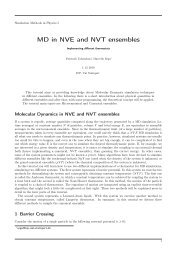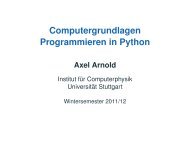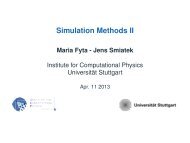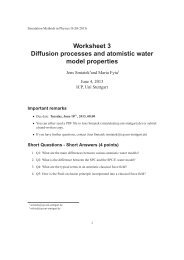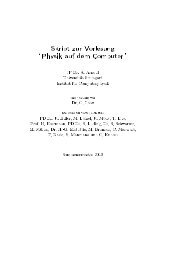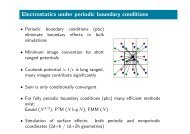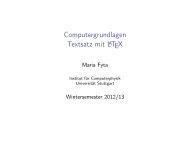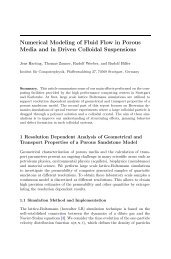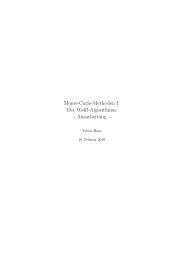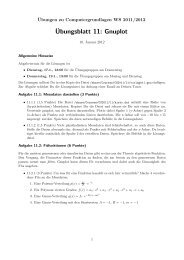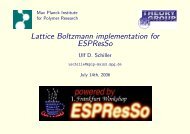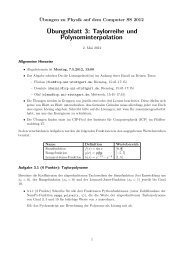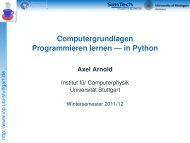Molecular dynamics and Monte Carlo simulation methods for soft ...
Molecular dynamics and Monte Carlo simulation methods for soft ...
Molecular dynamics and Monte Carlo simulation methods for soft ...
You also want an ePaper? Increase the reach of your titles
YUMPU automatically turns print PDFs into web optimized ePapers that Google loves.
<strong>Molecular</strong> <strong>dynamics</strong><br />
<strong>and</strong> <strong>Monte</strong> <strong>Carlo</strong><br />
<strong>simulation</strong> <strong>methods</strong><br />
<strong>for</strong> <strong>soft</strong> matter<br />
Martin Vögele<br />
17. 04. 2012<br />
Contents<br />
1 Soft Matter 2<br />
1.1 What is <strong>soft</strong> matter? . . . . . . . . . . . . . . . . . . . . . . . . . . . . . . . 2<br />
1.2 Why is <strong>soft</strong> matter <strong>soft</strong>? . . . . . . . . . . . . . . . . . . . . . . . . . . . . . 2<br />
1.3 Types of <strong>soft</strong> matter . . . . . . . . . . . . . . . . . . . . . . . . . . . . . . . 3<br />
1.3.1 Colloids . . . . . . . . . . . . . . . . . . . . . . . . . . . . . . . . . . 3<br />
1.3.2 Amphiphiles . . . . . . . . . . . . . . . . . . . . . . . . . . . . . . . . 3<br />
1.3.3 Polymeres . . . . . . . . . . . . . . . . . . . . . . . . . . . . . . . . . 4<br />
2 <strong>Molecular</strong> Dynamics Simulation 5<br />
2.1 Principles . . . . . . . . . . . . . . . . . . . . . . . . . . . . . . . . . . . . . 5<br />
2.2 Algorithms . . . . . . . . . . . . . . . . . . . . . . . . . . . . . . . . . . . . 5<br />
2.3 Observables . . . . . . . . . . . . . . . . . . . . . . . . . . . . . . . . . . . . 6<br />
2.4 Applications . . . . . . . . . . . . . . . . . . . . . . . . . . . . . . . . . . . . 6<br />
3 <strong>Monte</strong> <strong>Carlo</strong> Simulation 7<br />
3.1 Basics . . . . . . . . . . . . . . . . . . . . . . . . . . . . . . . . . . . . . . . 7<br />
3.2 Applications . . . . . . . . . . . . . . . . . . . . . . . . . . . . . . . . . . . . 7<br />
3.3 MC Integration . . . . . . . . . . . . . . . . . . . . . . . . . . . . . . . . . . 7<br />
3.3.1 Calculating π . . . . . . . . . . . . . . . . . . . . . . . . . . . . . . . 7<br />
3.3.2 Importance Sampling . . . . . . . . . . . . . . . . . . . . . . . . . . . 7<br />
3.4 Metropolis Algorithm . . . . . . . . . . . . . . . . . . . . . . . . . . . . . . 8<br />
4 Boundary Conditions 9<br />
4.1 Types of Boundary Conditions . . . . . . . . . . . . . . . . . . . . . . . . . 9<br />
4.2 Minimum Image Convention . . . . . . . . . . . . . . . . . . . . . . . . . . . 9<br />
4.3 Linked Cells <strong>and</strong> Neighbor Lists . . . . . . . . . . . . . . . . . . . . . . . . . 9
1 Soft Matter<br />
1.1 What is <strong>soft</strong> matter?<br />
The classical sorts of matter usually cosidered in physics are all homogeneous already on<br />
scales of nanomters. If one looks at a crystalline solid or at some kind of liquid, there is<br />
no more structure visible on that scale. But there are also more complex materials, where<br />
there are still structures up to nanometers which determine their typical behavior. This<br />
is shown <strong>for</strong> as suspension in figure 1, where we can see the different length scales with<br />
different structures: First the atomic scale, then the scale of the single layers <strong>and</strong> at last<br />
the range where the interface is only a line <strong>and</strong> just the different areas of oil <strong>and</strong> water are<br />
visible.<br />
Figure 1: lenght scales of <strong>soft</strong> matter [4]<br />
Based on this, we will use the following definition.<br />
Soft matter:<br />
Systems, whose properties are determined by structures in the mesoscopic scale (range<br />
between nano- <strong>and</strong> micrometers).<br />
1.2 Why is <strong>soft</strong> matter <strong>soft</strong>?<br />
Figure 2: shearing [4]<br />
The term <strong>soft</strong> matter describes one of its most important properties. We can underst<strong>and</strong><br />
this by estimating the shear modulus µ which as the resistance against a shearing <strong>for</strong>ce
(see figure 2). It is defined by<br />
F<br />
L x L y<br />
= µ ∆L x<br />
L z<br />
.<br />
As we can seee, the dimension is E · L −3 . For <strong>soft</strong> matter, the energy normally is in<br />
the thermical range, a typical value is k B T = (1/40) eV. The decisive part is the lattice<br />
constant. Let us assume a colloidal crystal. Its lattice size is 10000 times the one of a<br />
normal crystal, because that is the order of the determining structures. This means that<br />
<strong>soft</strong> matter has a shear modulus which is about 10 12 times smaller than the one of a typical<br />
solid.<br />
1.3 Types of <strong>soft</strong> matter<br />
1.3.1 Colloids<br />
Colloids are particles or drops with a size between 1 nm <strong>and</strong> 1 µm inside a liquid. The<br />
size differences are just in that range, where the surrounding liquid can be approximated<br />
as a continuum. This surrounding liquid causes thermal movement of the colloids by small<br />
collisions. The resulting movement of the particles is well-known as Brownian motion.<br />
The particles themselves can interact by hard sphere repulsion, electrostatic <strong>for</strong>ces, Van<br />
der Waals <strong>for</strong>ces <strong>and</strong> by entropic effects. Most of these interactions can easily be modified:<br />
the electrostatic <strong>for</strong>ce by inserting salt whose ions shield the electric potential, the Van<br />
der Waals <strong>for</strong>ces by changing the refraction index of the medium <strong>and</strong> the hard shpere <strong>and</strong><br />
entropic effects by changing the <strong>for</strong>m of the particles.<br />
Important <strong>for</strong> applications is the nonlinear dynamic behavior when a <strong>for</strong>ce is exerted. this<br />
is <strong>for</strong> example used in dispersion paint, which becomes hard as soon as it isn’t pressed<br />
against the wall any more.<br />
Figure 3: colloids in a medium [1]<br />
1.3.2 Amphiphiles<br />
Amphiphiles are molecules that are made up of a hydrophile head <strong>and</strong> lipophile tail. That<br />
is why they preferrably accumulate at interfaces when put into a system containing water<br />
<strong>and</strong> oil. Substances that are made up of these components are called microemulsions <strong>and</strong><br />
one can roughly distinguish between three sorts:
• more water ⇒ drops of oil in water<br />
• more oil ⇒ drops of water in oil<br />
• equal amounts ⇒ bicontinuous phase: water-oil-network<br />
In case there is only water <strong>and</strong> amphiphiles, they <strong>for</strong>m either spherical aggregates (mycels)<br />
or double layers (membranes).<br />
The widest-known application are tensides used <strong>for</strong> cleaning. A <strong>simulation</strong> <strong>for</strong> such a<br />
tenside is shown in figure 4.<br />
Figure 4: MD <strong>simulation</strong> of a system with 3350 tenside <strong>and</strong> 3200 water molecules.<br />
bottom right: r<strong>and</strong>om start configuration. [6]<br />
1.3.3 Polymeres<br />
Polymeres are chains of monomeres, that are connected by covalent bonds. These bonds<br />
can be rotated or flipped, which results in many degrees of freedom. This is why <strong>for</strong><br />
long polymeres the con<strong>for</strong>mation entropy is the dominat term in the free energy. So their<br />
behaivior can be described very well statistical <strong>methods</strong>, <strong>for</strong> example as a r<strong>and</strong>om walk.<br />
Figure 5: typical con<strong>for</strong>mation of a fluctuating polymer chain, simulated with MC<br />
method [4]
2 <strong>Molecular</strong> Dynamics Simulation<br />
2.1 Principles<br />
In molecular <strong>dynamics</strong> <strong>simulation</strong>s, one assumes a material (solid, liquid or gas) to contain a<br />
certain number N of classical particles. These particles interact by (mostly semiempirical)<br />
potentials v ij = v(⃗r ij ). By differentiating these potentials, one obtains the <strong>for</strong>ces<br />
⃗f i = ∑ i≠j<br />
⃗f ij = − ∑ i≠j<br />
∂v(⃗r ij )<br />
∂⃗r i<br />
which can be used to solve Newton’s equations <strong>for</strong> each particle.<br />
m i¨⃗ri = ⃗ f i<br />
So the trajectories <strong>for</strong> all particles can be obtained <strong>and</strong> used <strong>for</strong> calculating macroscopic<br />
properties.<br />
2.2 Algorithms<br />
As all many body problems, MD equations can’t be solved analytically. That’s why numerical<br />
algorithms have to be used. A good algorithm must be exact but nevertheless fast,<br />
so one has to find compromises. It also needs to be time-reversible <strong>and</strong> certain properties<br />
must be conserved (energy, momentum,...).<br />
The most most common algorithms <strong>for</strong> MD are:<br />
• Runge-Kutta 4th order<br />
• Verlet algorithm<br />
• Velocity Verlet algorithm<br />
• Predictor-corrector method<br />
Here the Verlet algorithm shall be shown as an example. It is derived by using two Taylor<br />
series of ⃗r i (backward <strong>and</strong> <strong>for</strong>ward):<br />
⃗r i (t + ∆t) = ⃗r i (t) + ∆t · ˙⃗r i + (∆t)2 ¨⃗r i + (∆t)3 d 3 ⃗r i<br />
2 6<br />
⃗r i (t − ∆t) = ⃗r i (t) − ∆t · ˙⃗r i + (∆t)2 ¨⃗r i − (∆t)3<br />
2 6<br />
Add both equations <strong>and</strong> use ¨⃗r i = ⃗ f i<br />
m i<br />
:<br />
dt 3 + O(∆t4 )<br />
d 3 ⃗r i<br />
dt 3 + O(∆t4 )<br />
⃗r i (t + ∆t) = 2⃗r i (t) − ⃗r i (t − ∆t) + ⃗ f i<br />
m i<br />
∆t 2 + O(∆t 4 )<br />
In this algorithm, the velocity is not needed, but the local coordinates of two steps be<strong>for</strong>e.<br />
The velocity can though be calculated as:<br />
v(t) = ⃗r i(t + ∆t) − ⃗r i (t − ∆t)<br />
2∆t<br />
Because of using <strong>for</strong>ward <strong>and</strong> backward series the Verlet algorithm is time-reversible <strong>and</strong><br />
it can also be shown that the energy is conserved.
2.3 Observables<br />
The MD <strong>simulation</strong> at first only gives the trajectories of the particles, but they can hardly<br />
be compared with experiments <strong>and</strong> anyway we are mostly interested in the macroscopic<br />
behavior. So macroscopic values, called observables, must be determined. they are usually<br />
evaluated by statistical averages over all particles. That’s where we need the ergodic hpothesis,<br />
which says that in a chaotic system, all accessible microstates are equally probable<br />
over a long time, so that the time average is equal to the statistical average: Ā t = 〈A〉.<br />
Important observables are the mean potential energy per particle, the mean kinetic energy<br />
per particle respectively the temperature or pressure.<br />
2.4 Applications<br />
• Nobel gases (classical example: liquid Argon)<br />
• Solid state physics:<br />
all sorts of solids, especially alloys<br />
• Astrophysics:<br />
planetary motion, behavior of galaxies<br />
• Fluid <strong>dynamics</strong>:<br />
Liquids that are too complex <strong>for</strong> assuming continuum<br />
• Biochemistry:<br />
Large molecules, proteins
3 <strong>Monte</strong> <strong>Carlo</strong> Simulation<br />
3.1 Basics<br />
<strong>Monte</strong> <strong>Carlo</strong> <strong>simulation</strong>s use probability theory to solve mathematical problems. the most<br />
important principles <strong>for</strong> the stochastical models are the law of large numbers <strong>and</strong> the<br />
central limit theorem which make shure that the probabilistic algorithm converges to a<br />
reproducible result <strong>for</strong> a sufficient number of r<strong>and</strong>om experiments. The results of such<br />
r<strong>and</strong>om experiments must always be analysed statistically. Depending on how elaborate<br />
the problem is, one can use naive <strong>methods</strong> with uni<strong>for</strong>mly distributed r<strong>and</strong>om numbers or<br />
adapted distributions, which is called importance sampling.<br />
3.2 Applications<br />
• Calculating integrals, especially in higher dimensions<br />
• evolution of galaxies<br />
• production processes<br />
• stock markets<br />
• weather <strong>and</strong> climate<br />
• calculating observables in quantum field theory<br />
• virtual reality <strong>and</strong> artificial intelligence<br />
3.3 MC Integration<br />
3.3.1 Calculating π<br />
One of the most simple (<strong>and</strong> the<br />
best-known) example <strong>for</strong> a <strong>Monte</strong><br />
<strong>Carlo</strong> integration is the stochastical<br />
determination of π. The algorithm<br />
is quite easy: Create a<br />
square with a quarter circle in it.<br />
Then choose N total r<strong>and</strong>om points<br />
in the square <strong>and</strong> count those who<br />
are inside the circle. The ratio is<br />
just π 4 .<br />
π<br />
4 = N inside<br />
N total<br />
Figure 6: statistical calculation of π [8]<br />
3.3.2 Importance Sampling<br />
Suppose we want to calculate averages of the type<br />
∫<br />
d⃗r exp [−βU(⃗r)] A(⃗r)<br />
〈A〉 = ∫<br />
d⃗r exp [−βU(⃗r)]
with p(⃗r) being the probability density to find the system in a state around ⃗r:<br />
∫<br />
exp [−βU(⃗r)]<br />
p(⃗r) = with Z = d⃗r exp [−βU(⃗r)]<br />
Z<br />
Our problem is that the direct calculation of Z is too time-consuming. The solution is using<br />
importance sampling: We generate r<strong>and</strong>om states according to a probability distribution<br />
w(⃗r). So <strong>for</strong> the average holds:<br />
〈A〉 ≈<br />
∑ N<br />
i=1 exp [−βU(⃗r i)] A(⃗r i )/w(⃗r i )<br />
∑ N<br />
i=1 exp [−βU(⃗r i)] /w(⃗r i )<br />
If we choose w(⃗r) = exp [−βU(⃗r)] the average 〈A〉 simplifies:<br />
⇒ 〈A〉 ≈ 1 N<br />
N∑<br />
A(⃗r i )<br />
i=1<br />
3.4 Metropolis Algorithm<br />
The Metropolis algorithm creates a series of r<strong>and</strong>om variables, where the probability <strong>for</strong> a<br />
new state only depends on the probability <strong>for</strong> the previous one (Markov chain). Starting<br />
from the initial value x 0 , generate a potential successive value x 1 <strong>and</strong> calculate the transition<br />
probability p(x 0 , x 1 ). Then generate a r<strong>and</strong>om number r ∈ [0, 1] <strong>and</strong> sccept the new<br />
value if p(x 0 , x 1 ) > r.<br />
Figure 7: 2D Ising model 300×300, spin up/down as white/black. [7]<br />
One very famous example is the Ising model <strong>for</strong> magnetization, where spins are placed on a<br />
lattice with external magnetic field H z . It is assumed that they can only be +1 or −1. The<br />
energy of the system is determined by the Hamiltonian Ĥ = − 1 2<br />
∑ij J ∑<br />
ijs i s j + H z i s i.<br />
The spins flip with a certain probability p = exp[−β(E new − E old )] <strong>for</strong> E new > E old <strong>and</strong><br />
p = 1 <strong>for</strong> E new < E old . In this model, critical points can be determined <strong>and</strong> domains of<br />
different magnetization can be observed as in figure 7.
4 Boundary Conditions<br />
4.1 Types of Boundary Conditions<br />
The number of particles in a <strong>simulation</strong> is<br />
limited by calculation time <strong>and</strong> memory capacity.<br />
For sufficiently small systems, the<br />
boundary conditions can be obtained directly<br />
from the real problem. But most real<br />
systems are much larger. And because usually<br />
there is a different behavior at the surface<br />
<strong>and</strong> inside the system, artificial boundary<br />
conditions must be defined.<br />
One option is the hard walls model, where<br />
every particle hitting the wall is reflected.<br />
These walls are like a vessel <strong>for</strong> the simulated<br />
material. But surface <strong>and</strong> volume<br />
can not be scaled linearly, which results in<br />
many unwanted effects.<br />
The more common choice are there<strong>for</strong>e periodic<br />
bondary conditions: A particle that<br />
Figure 8: periodic boundary conditions<br />
leaves the <strong>simulation</strong> box, enters at the<br />
opposite side with same velocity. This is<br />
equivalent to an infinitely large, periodic volume, which often is much nearer to the properties<br />
of a macroscopic system.<br />
4.2 Minimum Image Convention<br />
Periodic boundary conditions result in an infinite number of particles. This would lead to<br />
an infinite number of interactions which would need infinitely much time to be calculated.<br />
This problem is solved by the minimum image convention. For each particle, one can<br />
consider only the region inside a so called cut-off radius r cut , where the interaction potential<br />
is truncated. This is a very good approximation <strong>for</strong> short range interactions.<br />
4.3 Linked Cells <strong>and</strong> Neighbor Lists<br />
There are two ways of speeding up a calculation with beriodic boundary conditions.<br />
The first one is the linked cell method. The <strong>simulation</strong> area is partitioned into cells <strong>and</strong><br />
one must consider only particles in neighbor cells. Of course, the side length of the cells<br />
must be bigger than r cut or else the potential is cut off too near.<br />
The second possibility is using neigbor lists, that contains <strong>for</strong> each particle all neighbors<br />
inside a list radius r l > r cut <strong>and</strong> only those are used <strong>for</strong> the calculation. These lists must<br />
be updated from time to time, so this method is only useful <strong>for</strong> large numbers of particles.
References<br />
[1] SoftSimu - Biophysics <strong>and</strong> Soft Matter. http://www.<strong>soft</strong>simu.net<br />
[2] Allen, M. P. ; Tildesley, D. J.: Computer Simulation of Liquids. Ox<strong>for</strong>d University<br />
Press, USA, 1989. – ISBN 0198556454<br />
[3] Frenkel, Daan ; Smit, Berend: Underst<strong>and</strong>ing <strong>Molecular</strong> Simulation, Second Edition:<br />
From Algorithms to Applications. Academic Press, 2002. – ISBN 0–12–267351–4<br />
[4] Gompper, Gerhard ; Dhont, Jan K. G. ; Richter, Dieter: Komplexe Materialien<br />
auf mesoskopischer Skala: Was ist Weiche Materie? In: Physik in unserer Zeit 34<br />
(2003), Nr. 1, S. 12–18. – ISSN 1521–3943<br />
[5] Griebel, Michael ; Knapek, Stephan ; Zumbusch, Gerhard ; Caglar, Attila: Numerische<br />
Simulation in der Moleküldynamik: Numerik, Algorithmen, Parallelisierung,<br />
Anwendungen. Springer, 2004. – ISBN 3–540–41856–3<br />
[6] Hentschke, R. Theoretische Chemische Physik. http://constanze.materials.uniwuppertal.de/Beispiele.html<br />
[7] Juul, Jeppe. The Ising Model. http://jeppejuul.com/proposed-projects/bachelorsproject/the-ising-model/<br />
[8] Wikipedia: Kreiszahl — Wikipedia, Die freie Enzyklopädie.<br />
http://de.wikipedia.org/w/index.php?title=Kreiszahl&oldid=101469010. 2012. –<br />
[Online; St<strong>and</strong> 8. April 2012]



